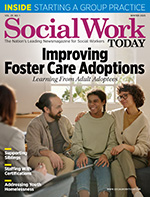|
Winter 2025 Issue Improving Foster Care Adoptions Learning From Adult Adoptees Adoption is a common path to permanency for many youths in foster care, but often the voice of the foster care adoptee is underrepresented in discussions. “Adoption,” according to one foster care adult adoptee, “is a lifelong experience, and those working in the field of adoption should provide ongoing support and resources to adoptive families, birth parents, and adopted individuals throughout their lives.” Although adoption and family preservation/reunification are often depicted as opposing approaches to child welfare, both can work together in different circumstances to provide children with safe and loving homes. Discussing Adoption Although family preservation is the primary goal of foster care, not every child can safely return to their biological family. Recent statistics show that in FY 2022, 18,538 children aged out of foster care, and less than 15% of children available for adoption were living in a preadoptive home.1 When reunification is not possible, adoption can provide stability and prevent children from aging out, which puts them at a higher risk for unemployment, sex trafficking, homelessness, and substance abuse. Every year, thousands of social workers in the United States walk alongside children referred to the child welfare system, through court hearings, adoptive family recruitment and placement, and postplacement visits and services. The National Council for Adoption released a study in May 2024 called “Profiles in Adoption: Adult Adoptee Experiences,”2 which focused on the lived experience of 1,247 adoptees, 154 of whom were adopted from foster care. Based on the study findings, the following are some ways that child welfare social workers can improve foster care adoptions. Suitability of Family Matches Whenever possible, social workers should advocate for finding kinship matches, which can keep children connected with their families of origin. Recent statistics show that 55% of foster care adoptees were adopted by their foster parents and 34% by a relative.3 Adoptees from foster care selected the most important factors to consider in family matches as adoptive parents’ age (64%), lack of or number of children in the home (52%), and race (51%). They also expressed the need for thorough caregiver screenings to assess overall compatibility and aligned motivations. Child-Centric Decision-Making Through court-appointed special advocate (CASA) programs and home visits, social workers can gain insight on the child’s holistic well-being and how they are faring in their current placement. CASA programs are usually designed to share the child’s perspective (the voice of the child) with the court and make recommendations on what would be in the child’s best interest, which is especially helpful for young children, who may struggle with the vocabulary to self-advocate. Older children and teens can participate in the adoptive family recruitment process by suggesting or evaluating family matches and contributing to the photo listing and narrative shared with prospective families. Some adult adoptees suggested that legal guardianship could be explored as an alternative to traditional adoption depending on the youth’s age and preferences. Parent Training Additionally, parents may need support to navigate multiethnic adoptions, which account for 30% of domestic adoptions.4 Although 78% of adoptees from foster care agreed that parents should be allowed to adopt a child of a different ethnicity, only 48.5% believed their parents sufficiently discussed race and culture. It would be helpful to provide training to multiethnic families on how to talk about sensitive issues, incorporate the child’s culture, recognize unconscious bias, address bullying and insensitive comments from others, and foster inclusive environments. It’s also important to make adoptive parents aware of trauma-informed parenting resources. Parents need to be equipped to handle grief and loss, attachment, and behavioral issues. Assistance could involve external resources, like Trust-Based Relational Intervention training, and support groups with community organizations that offer networking and sharing opportunities with other adoptive families. When asked what advice they would give to future adoptive parents, adoptees participating in the study expressed that an environment of openness and belonging, as well as child-centered positive parenting, helped overcome feelings of distance and insecurity in their familial relationships.2 Birth Family Engagement According to one adoptee, “[There should be] acknowledgment that there are thoughts and feelings about the birth family and recognition that their adoption by one family means the loss of another.”2 Adoptees overwhelmingly wanted the opportunity to find, contact, and visit their birth family postadoption. Bolstering Mental Health Services Social workers can point adoptees to funding for mental health services through state Medicaid programs, as finances can be a barrier to accessing care, and recommend therapists who specialize in foster care and adoption. Recommendations for Nonchild Welfare Social Workers Understanding the unique experiences of adoptees can help social workers from all backgrounds navigate conversations with empathy and compassion. The following are a few recommendations for social workers in other fields. Become Trauma-Informed For children specifically, trauma rewires the brain and can affect how they deal with social situations and cope with stressors. Children in foster care or adopted from foster care may be clinically diagnosed with depression, anxiety, or other mental health issues, but can overcome these challenges with the right support system. Trauma-informed care has broader applications beyond supporting children who have experienced abuse or neglect and can be useful regardless of specialization. Point Adoptees and Their Parents to Available Resources More than 90% of families qualify for federal and/or state adoption assistance,5 such as monthly payments, Medicaid coverage, respite care, adoption cost reimbursement, and college tuition or job-finding resources. Social workers can facilitate family and adoptee referrals to resources by familiarizing themselves with the available options. Provide Additional Educational Accommodations Not all schools are equipped to deal with students who have experienced significant disruptions, so social workers can help students receive the support they need to catch up to grade level through individualized education plans and 504 plans. Furthermore, they can collaborate with the teachers and school staff to ensure that the children are well-integrated socially and behaviorally. Thriving Foster Care Adoptions In terms of life satisfaction, respondents who were adopted from foster care had a mean score of 3.37 out of five, in line with that of the general public, proving that adoptees are largely able to go on to lead happy and successful lives.2 In an example of a successful foster care adoption, Chauncey Strong, MSW, was adopted from foster care with his two brothers at the age of 5 and has since enjoyed a 30-year career in child welfare. He says, “Growing up, and before having a full understanding of adoption, I had some concerns about my adoption and wanted to ‘be good,’ so [my adoptive parents] didn’t send us back. … My adoptive parents talked openly about adoption and I consider my adoption to be a huge blessing. For me, it came full circle as well because I was able to connect with my birth family [as an adult]. I’ve seen over time that there was a purpose to foster care and adoption, and now I want to help children and youth know that no matter how they started in life they can be successful.” By providing support and understanding to foster care adoptees and their families, more foster care adoptees can thrive in their new environments and more families will be willing and optimally prepared to open their homes to children in need. — Leah Sutterlin is an adoptee and adoption communication manager at the National Council for Adoption and has worked on foster care issues nationally with the Christian Alliance for Orphans’ More Than Enough team. — Ryan Hanlon, PhD, is the president of the National Council for Adoption (NCFA). Prior to joining NCFA, he served as the executive director of an accredited adoption agency that provided domestic and international adoption services.
References 2. Hanlon R, Davi N, Quade M, Lindner A. Profiles in adoption – adult adoptee experiences. https://adoptioncouncil.org/wp-content/uploads/2024/04/Profiles_in_Adoption_-_Adult_Adoptee_Experiences_-_Final.pdf. Published 2024. Accessed August 27, 2024. 3. Fact sheets. Congressional Coalition on Adoption Institute website. https://www.ccainstitute.org/resources/fact-sheets 4. Blassingame H.The journey of transracial adoption. NPR Illinois website. https://www.nprillinois.org/2023-01-24/the-journey-of-transracial-adoption. Published January 24, 2023. 5. Adoption assistance. Families Rising website. https://wearefamiliesrising.org/adoption-assistance/ 6. The impact of education in foster care and adoption. FosterUSKids website. https://www.fosteruskids.org/blog/the-impact-of-education-in-foster-care-and-adoption |


